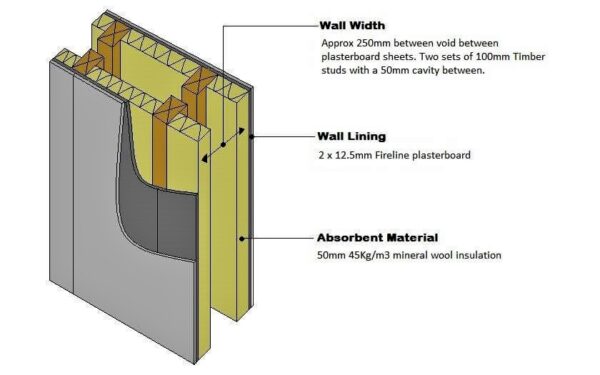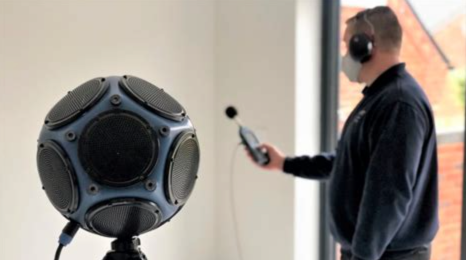-
Call Us
353 (0)21 7004001, 087 333 0547 - Unit B4, Link Road Business Park
Ballincollig, Co. Cork, P31 W950

11
Jul 22Improving Party Wall Soundproofing To Pass Sound Testing
- July 11, 2022
Have you ever wondered why your neighbor’s music is so loud? It’s because they have no soundproofing. But you can solve this issue.
The party wall is the shared wall between two houses. If you own a property with a party wall, you may be familiar with sound traveling through it. Neighbors, pets can cause it, or even parties happening in the house next door. If you grapple with sleeping at night because of noise coming from your neighbors’ house, there are ways to improve party wall soundproofing to pass sound provings.
Soundproofing your party wall is a vital option for homeowners who want to prevent their neighbors from hearing their music, voices, or TV. The process involves installing insulation between two properties and covering both sides of the wall with reflective material. It helps reduce noise that enters the property from outside and keeps it from escaping into your neighbor’s home.
Soundproofing materials should be installed to prevent air leakage and reduce sound transfer between rooms. Some materials include insulation foam and fiberglass panels placed between walls on either side of a doorway or window; these materials prevent sound waves from entering one room but allow them to exit another room without being heard by anyone outside. More tips include:
• Test for air leaks
• Seal air leaks with drywall tape
• Seal air leaks with acoustic sealant
• Replace damaged insulation
• Replace damaged drywall
• Replace damaged plasterboard
• Replace damaged ceilings
• Install soundproofing doors and windows
• Install soundproofing flooring and wiring under the floorboards
• Install soundproofing ductwork under the floorboards
Why Do Most Party Wall Sound Trials Fail?
1. Through Structural Steel
It can be a source of noise transmission between adjoining buildings. When the original building is constructed, it is important to ensure that the structural steel used in the construction is free of defects or flaws that could lead to noise transmission.
2. Plumbing Chases
Plumbing chases are another common source of sound transmission between adjoining buildings. When plumbing chases are installed in a building, they must be sealed properly so that no noise can escape from these spaces into other areas of the building. It can be done by using foam seals around pipes or acoustic sealant on walls where plumbing chases are located.
3. Fixtures and Fittings
Fixtures and fittings can also be a significant source of noise transmission from one building to another if they are not properly installed at the time of construction or upgrade work being done later on down the road after your initial build-out has been completed. For example, if you install a new fan inside your home without adding any insulation between its motor casing and ceiling joists above.
4. Shared Components
Complete air tightness solutions are also available. Shared components like floorboards or interior walls can be another source of failed party wall sound trials. When these components share space between two buildings, they can transfer vibrations between them, making it difficult for builders to ensure their work will not disturb neighbors.
5. Through Windows
The most common cause of party wall sound trials failing is through windows. If you are having your neighbor’s party wall tested, it can be very difficult to stop the sound from coming through the window. There are ways to prevent this from happening, but they involve using unique materials or installing specific products that allow sounds to escape the room.
6. Around The Edge of The Partition Through An Adjacent Wall
This is because most sound travels up through this area, so if there is a gap between them, this can cause noise transfer problems between your neighbor’s home and yours.

A Noise-Reducing Solution for Party Walls
If you are looking for a quick way to reduce noise through party walls, we recommend dividing wall partitions. You can install 70 mm met sec between two adjoining walls and leave a backspace of a met sec with the wall 25 mm thick. Then, add 50 mm of acoustic wool on both sides of this partition. Finally, add 1 x 15 mm and 1 x 12.5 mm layers of the soundboard to the ceiling and floor, respectively.
For Your Sound Examination Visit to Be a Success, We Suggest That You Prepare By
- Downloading our Sound proving list
- Building rooftop, internal, and floors to be finished
- Windows and doors should be fitting correctly
- Install power supply for testing apparatus (Typical 240-volt power), including an electric panel with breakers and switches, electric meter box, and junction box
- Install drywall between floors on all levels
- Install ceiling tiles in common area areas like halls, stairwells, and landings; finish the ceilings with paint or drywall compound (if needed)
- Install carpet in common areas; finish with padding
- Install plumbing fixtures in bathrooms, kitchens, and laundry rooms; finish with paint or glaze.
- Install countertops in kitchens; finish by installing faucet handles/sprayers (if applicable)
- Install light fixtures along hallways, stairwells, and landings; finish by installing bulbs (if applicable)
The actions you take to improve sound trial should follow BRP-E.
First, you need to define the problem. What is it that you want to change?
Second, you should research it. How has this issue been handled in the past? What are your options for solving it?
Third, create a plan that includes specific steps for reaching your goal. What will happen when you’re done with each step?
Fourth, execute that plan. Put your knowledge and skills into action by following through on what you’ve set out to do.

Why Choose Us for Your Acoustic Project and Sound Trial
BERL.IE is your go-to for acoustics and sound testing. We offer a wide range of solutions to suit any need, from air tightness solutions to sound trials.
We are a company that has been in business for years, so we know how to get the job done right.
We believe in providing a quality service at an affordable price for all our clients, whether they are large or small businesses.
If you need any help with your acoustics or sound proving needs, then don’t hesitate to get in touch with us today.
